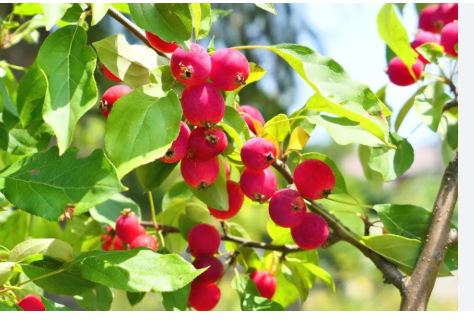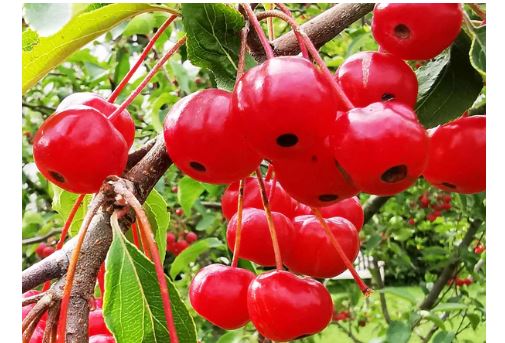
The Malus baccata, commonly known as the Siberian Crabapple, is a robust, cold-hardy, and versatile deciduous tree celebrated for its profuse spring blossoms, small edible fruits, and exceptional adaptability to harsh climates. As a species within the Malus genus, this tree is a cornerstone of ornamental horticulture and a valuable parent for many hybrid crabapple cultivars. Its resilience, vibrant seasonal displays, and ecological benefits make it a favorite for gardeners, landscapers, and orchardists.
Botanical Classification
The Siberian Crabapple belongs to the following taxonomic classification:
- Kingdom: Plantae
- Phylum: Tracheophyta
- Class: Magnoliopsida
- Order: Rosales
- Family: Rosaceae
- Genus: Malus
- Species: baccata
- Common Names: Siberian Crabapple, Manchurian Crabapple, Chinese Crabapple
Unlike hybrid cultivars, Malus baccata is a true species within the Malus genus, which includes both apples and crabapples. Crabapples are typically distinguished by their smaller fruit (less than 2 inches in diameter). Malus baccata is a wild species native to Asia, known for its cold hardiness and genetic contributions to many modern crabapple cultivars, such as Dolgo and Red Splendor.
History of the Siberian Crabapple
The Siberian Crabapple has a rich history rooted in its native range across Asia, where it has been valued for centuries for its fruit, wood, and ornamental qualities. Originating in the cold, temperate regions of Siberia, northern China, and Mongolia, Malus baccata was first documented in Western horticulture in the 18th century when European botanists began collecting Asian plant species.
It was introduced to North America and Europe in the late 1700s to early 1800s by plant explorers like Niels Ebbesen Hansen, who recognized its potential for cold climates and hybridization.
In the late 19th century, Hansen, a renowned horticulturist at the South Dakota Agricultural Experiment Station, used Malus baccata extensively in breeding programs to develop cold-hardy, disease-resistant crabapples, including the Dolgo Crabapple. Its genetic resilience has made it a foundational species for modern crabapple cultivars, prized for their ornamental beauty and adaptability.
In its native range, Indigenous peoples and local communities used the fruit for food and medicine, while the tree’s wood was valued for tools and fuel. Today, Malus baccata is widely cultivated in temperate regions for its ornamental appeal and ecological contributions.
Native Area
Malus baccata is native to northern Asia, with a broad range spanning:
- Siberia (Russia)
- Northern China (Manchuria, Heilongjiang, Inner Mongolia)
- Mongolia
- Northern Korea
- Parts of Japan (Hokkaido)
It thrives in cold, temperate climates, often found in open woodlands, forest edges, and mountainous regions up to 4,000 feet in elevation. The tree’s natural habitat includes areas with harsh winters and short growing seasons, contributing to its exceptional cold hardiness. While not native to North America, it has naturalized in some regions since its introduction, particularly in colder climates like the northern United States and Canada, where it is grown as an ornamental and rootstock species.
Identifying Characteristics

The Siberian Crabapple is known for its vigorous growth, abundant blooms, and small, colorful fruits.
- Size and Shape: This medium to large deciduous tree grows to a height of 20–40 feet with a spread of 20–30 feet, forming a rounded, spreading, or irregular canopy. Its size varies depending on rootstock and growing conditions, with smaller forms (15–20 feet) possible on dwarf or semi-dwarf rootstocks.
- Foliage: The leaves are simple, ovate to elliptical, 2–3 inches long, with finely serrated margins. They emerge bright green in spring, mature to dark green with a glossy finish in summer, and turn yellow to orange in fall, providing seasonal interest.
- Flowers: In early to mid spring (April–May), the tree produces profuse fragrant, white to pale pink flowers (1–1.5 inches in diameter) that open from pink to red buds. The five-petaled blooms, arranged in clusters (corymbs), create a spectacular display, covering the branches and attracting pollinators like honeybees, bumblebees, mason bees, and butterflies.
- Fruit: Following the blooms, the tree develops small, red, yellow, or red-blushed yellow pomes (0.3–0.5 inches in diameter), ripening in late summer to early fall (August–October). These berry-like fruits persist into late fall or early winter, providing food for wildlife. The fruits are tart but edible, with a crisp, apple-like flavor.
- Bark: The bark is greyish-brown, smooth when young, and becomes scaly or fissured with age. It adds texture to the winter silhouette, especially in colder climates where the tree’s structure is exposed.
- Growth Habit: The tree’s rounded to spreading canopy with strong, ascending branches supports heavy flower and fruit production. Its vigorous growth and open habit make it a striking focal point in landscapes, though it may require pruning to maintain shape in formal settings.
Uses of the Siberian Crabapple
Malus baccata is a multi-purpose tree valued for its ornamental beauty, ecological contributions, and practical applications. Its uses include:
- Landscaping: The tree’s profuse blooms, colorful fruit, and attractive form make it ideal for specimen planting, accent trees, hedges, or windbreaks. Its cold hardiness suits northern climates, while its size makes it appropriate for larger landscapes, parks, or rural settings. On dwarf or semi-dwarf rootstocks, it fits smaller gardens or urban spaces.
- Culinary Uses: The small, tart fruits are edible and high in pectin, making them excellent for jellies, preserves, sauces, cider, and vinegar. While not typically eaten raw due to their astringency, they can be sweetened and cooked for culinary use, offering a tangy, apple-like flavor. In its native range, the fruits were traditionally fermented into beverages or used in desserts.
- Wildlife Support: The fragrant flowers attract pollinators like honeybees, bumblebees, and butterflies, supporting early-season pollination. The persistent fruits are a vital food source for songbirds (e.g., robins, cedar waxwings, bluebirds) and small mammals (e.g., squirrels, foxes) from late summer through winter. The tree also serves as a host plant for butterfly and moth larvae, enhancing biodiversity.
- Pollination: Malus baccata is self-sterile, requiring cross-pollination with another Malus species or cultivar (e.g., another crabapple or apple tree) blooming simultaneously to produce fruit. Its early bloom and abundant pollen make it an excellent pollinator for early- and mid-season apple trees, boosting orchard yields. It is widely used as a pollinator in commercial and home orchards.
- Rootstock: Malus baccata is a common rootstock for grafting apple and crabapple cultivars due to its cold hardiness, disease resistance, and vigorous growth. Rootstocks like B.9 and B.118, derived from Malus baccata, are used to produce dwarf and semi-dwarf trees with improved winter survival.
- Medicinal and Traditional Uses: In its native range, the fruits and bark have been used in traditional medicine for their malic and tartaric acid content to treat digestive issues, inflammation, or as an antiseptic. The fruits were also used as a food preservative due to their high acidity.
- Wood: The hard, dense wood of Malus baccata is occasionally used for tool handles, firewood, or as a smoking wood for foods, imparting a mild, apple-like aroma.
- Cultural Significance: In Asian cultures, crabapple trees symbolize resilience and renewal due to their ability to thrive in harsh conditions. In Siberia and China, Malus baccata has been used in traditional ceremonies and as a food source during lean winters.
Growth Rate
Malus baccata has a fast growth rate, adding 12–24 inches per year under optimal conditions. It reaches flowering and fruiting maturity within 2–4 years, making it highly precocious compared to other crabapples.
On standard rootstocks, it achieves a mature height of 20–40 feet in approximately 10–15 years, while dwarf or semi-dwarf rootstocks (e.g., B.9, B.118) limit height to 10–20 feet. Its vigorous growth and early bearing make it ideal for gardeners seeking quick results in cold climates.
USDA Hardiness Zones
The Siberian Crabapple thrives in USDA Hardiness Zones 2–8, tolerating extreme winter temperatures as low as -50°F in Zone 2, making it one of the most cold-hardy crabapple species. It performs well in warm, temperate summers but may struggle in very hot, humid climates (Zone 9 or higher) due to insufficient chill hours (approximately 400–600 hours below 45°F required for fruit set).
The tree prefers full sun (6+ hours daily) to maximize flowering and fruiting but tolerates partial shade with reduced bloom and fruit production. It grows best in well-drained, slightly acidic to neutral soils (pH 5.0–7.0) but adapts to a wide range of soil types, including clay, loam, and sandy soils. Once established, it is drought-tolerant, pollution-resistant, and moderately tolerant of salt spray, making it suitable for urban and coastal plantings.
Fun Fact
The Siberian Crabapple (Malus baccata) is one of the hardiest fruit-bearing trees in the world, capable of surviving temperatures as low as -50°F in its native Siberian range. Its resilience inspired Russian folklore, where it was called the “tree of endurance,” symbolizing survival through harsh winters. This cold hardiness has made it a key parent species for many modern crabapple cultivars, earning it a legacy as the “backbone of northern orchards.”
Care and Maintenance Tips
To ensure the Siberian Crabapple thrives, follow these care tips:
- Planting: Choose a sunny, well-drained site with good air circulation to minimize disease. Dig a hole twice as wide and as deep as the root ball, incorporating compost to enrich slightly acidic soil. Plant in spring or fall, ensuring the root ball’s top is level with the ground. Water deeply and apply a 2–3-inch layer of organic mulch (e.g., wood chips), keeping it away from the trunk to prevent rot. Space plants 15–20 feet apart to accommodate mature size.
- Watering: Water regularly (weekly, 12–15 gallons) during the first year to establish roots, using the “finger test” (water if soil is dry 2 inches down). Once established, water during prolonged dry spells or extreme heat. Avoid overwatering to prevent root rot.
- Pruning: Prune in late winter or early spring while dormant to remove dead, diseased, or crossing branches, water sprouts, and suckers. Shape to maintain an open canopy for air circulation and sunlight penetration. Avoid spring pruning to reduce fire blight risk. Sanitize tools between cuts to prevent disease spread.
- Fertilization: If planted in fertile soil, fertilization is rarely needed. In poor soils, apply a slow-release, balanced fertilizer (e.g., 10-10-10) or compost in early spring before growth begins. Avoid over-fertilizing, as excess nitrogen can increase disease susceptibility.
- Pest and Disease Control: Malus baccata has good resistance to apple scab, cedar-apple rust, and powdery mildew but is susceptible to fire blight in humid conditions. Monitor for minor pests like aphids, codling moths, or spider mites, which can be managed with horticultural soap or beneficial insects like ladybugs. Avoid planting near junipers, which host cedar-apple rust.
- Site Selection: Plant 15–20 feet from buildings or other trees to accommodate its mature spread and ensure air circulation. Its cold hardiness makes it ideal for northern climates, but avoid heavy road salt exposure, as salt tolerance is moderate.
Challenges and Considerations
While the Siberian Crabapple is low-maintenance, consider the following:
- Fire Blight Susceptibility: The tree is susceptible to fire blight, particularly in warm, humid conditions. Proper pruning, good air circulation, and avoiding high-nitrogen fertilizers reduce risks.
- Fruit Drop: The small fruits may drop in late fall or early winter, requiring cleanup in high-traffic areas like sidewalks or driveways. The fruit size minimizes mess compared to larger crabapples.
- Pollination Requirements: As a self-sterile species, it requires a nearby Malus cultivar or species (e.g., another crabapple or apple tree) blooming simultaneously for fruit production. Ensure a compatible pollinator is within 50–100 feet.
- Seed Toxicity: Like all Malus species, the seeds contain trace amounts of amygdalin, which can break down into cyanide if crushed and ingested in large quantities. The risk is minimal, as the tart fruits are not typically consumed raw, and whole seeds pass through the digestive system harmlessly. Supervise pets to avoid ingesting large quantities of fruit.
- Size Management: On standard rootstocks, the tree can reach 40 feet, which may be too large for small yards. Choose dwarf or semi-dwarf rootstocks (e.g., B.9, B.118) for smaller spaces.